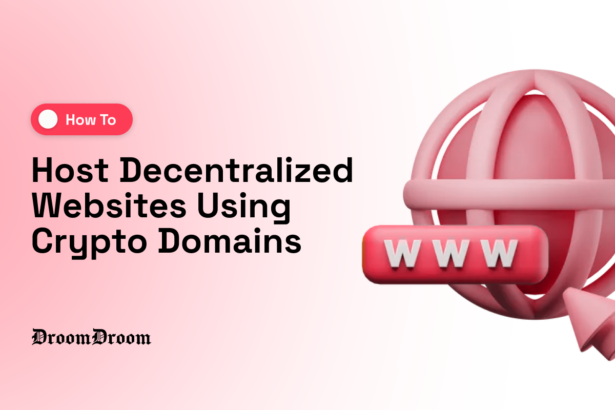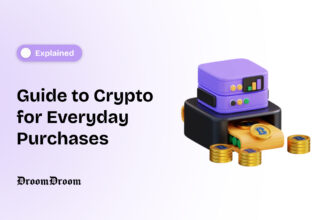Decentralized technologies are booming and they’re changing the way we look at finance, data and even how we use the internet. One new area which is gaining huge attention is the rise of decentralized websites.
- What Are Decentralized Websites?
- What Are Crypto Domains?
- Why Use Crypto Domains for Hosting?
- How to Host a Decentralized Website Using Crypto Domains
- First You Have to Purchase a Crypto Domain
- The Second Step Is to Choose a Decentralized Storage
- The Third Step Is to Upload Your Website to the Storage
- The Fourth Step Is to Link Your Crypto Domain to the Website
- Final Step, Is to Access Your Decentralized Website!
- Final Thoughts
These decentralized websites, powered by blockchain and hosted using crypto domains. These websites provide more control, a better censorship resistance and better security
Sounds exciting, right?
Let’s dive into what decentralized websites are, how crypto domains work and how you can host one.
What Are Decentralized Websites?
A decentralized website operates on a network that doesn’t rely on a single server. Traditionally websites are hosted on central servers owned by companies. This gives those companies a lot of power—they can control or even take down your site.
Not ideal, is it?
But decentralized websites change that. They run on peer-to-peer networks, which store data across many nodes instead of one centralized location. This setup makes them resilient to censorship, attacks and any downtime. Thus, no more worrying about a single point of failure.
What Are Crypto Domains?
Crypto domains are domain names that live on blockchain networks. Instead of traditional domains controlled by organizations like ICANN, crypto domains are yours once you own them. They’re stored on public ledgers like Ethereum or other blockchains.
You own it, period.
There’s no renewal fee, no authority that can take it from you.
But what exactly are these crypto domains? Let’s break it down.
Two popular platforms that currently offer blockchain domains are as follows.
Unstoppable Domains
These offer domains like .crypto, .zil and .nft. You can use these to host websites, make cryptocurrency payments and build digital identities.
ENS (Ethereum Name Service)
ENS provides .eth domains. These are integrated with Ethereum and allow users to link a domain to a website or even a cryptocurrency wallet.
Now, you might be thinking—why bother? Well, here’s why.
Why Use Crypto Domains for Hosting?
The advantages are hard to ignore. Let’s look at some of them.
Censorship Resistance
Traditional hosting providers can remove your website if it violates their rules or receives legal pressure. But decentralized websites live on networks without a central authority. No one can just “take it down.”
Better Security
Since your domain is on the blockchain, it’s much more secure. Blockchain tech is known for its safety features. Hackers have a harder time cracking decentralized sites than centralized ones.
Full Ownership
You actually own the domain. Unlike traditional domain names, no one can take it from you as long as you hold the private key. It’s yours for life.
Global Accessibility
Unlike traditional websites, decentralized websites are available everywhere. Governments or ISPs can’t block them. Cool, right?
How to Host a Decentralized Website Using Crypto Domains
Here’s a step-by-step guide to hosting your very own decentralized website.
First You Have to Purchase a Crypto Domain
This is a straightforward process.
- Head over to Unstoppable Domains or ENS.
- Browse for the domain name you want (for example, yourname.crypto or yourname.eth).
- Purchase the domain using cryptocurrency or a credit card, whichever works best for you.
- Once bought, your domain will be stored in your cryptocurrency wallet. Now, you have got full control.
The Second Step Is to Choose a Decentralized Storage
Next, you’ll need somewhere to store your website files. Since we are going decentralized, you’ll want a decentralized storage platform.
Two popular choices currently exist are IPFS and Arweave
IPFS lets you store your files on a peer-to-peer network. Instead of a traditional file system, it stores files based on their content and spreads them across the network.
Arweave blockchain-based storage system allows for permanent website storage. Upload your files once and they stay online forever.
The Third Step Is to Upload Your Website to the Storage
Now, let’s get your site online.
If you’re using IPFS, here is how to do it.
- Install an IPFS client, like the IPFS Desktop app.
- Add your website files (HTML, CSS, images, etc.) to the IPFS network by uploading them.
- You’ll get a content hash, which is a unique identifier that points to your website files.
- Pin the content and ensure it stays on the network.
Arweave follows a similar process—upload your website files and they’re there for good.
The Fourth Step Is to Link Your Crypto Domain to the Website
Now that your site is uploaded, you need to link it to your crypto domain.
For both Unstoppable Domains and ENS, the process of linking your crypto domain to your website’s content is straightforward.
With Unstoppable Domains you have to simply log in to your account, locate your domain and point it to your website’s IPFS hash using their built-in IPFS integration. This makes the process seamless.
For ENS, you’ll need to link your .eth domain to your website’s IPFS content hash by completing an Ethereum transaction. Once the transaction is confirmed, your domain will resolve to your IPFS-hosted website. And so, making it accessible across decentralized networks.
Final Step, Is to Access Your Decentralized Website!
Brave and Opera browser support decentralized websites by default. But, if you’re using Chrome or Firefox, you can install browser extensions like MetaMask to access them. These extensions are easy to download, consume less space and are free to access.
Final Thoughts
Hosting decentralized websites with crypto domains is going to be a game-changer for the future of the internet. It gives you much more freedom and much better security. The days where hosting companies or governments could dictate what content stays online are now gone. With blockchain domains and decentralized storage, you are the one who is in charge.
Do not make the mistake to think this is just a niche idea. As blockchain technology grows, decentralized websites may very well become the standard.
The internet is changing, so why not get ahead of the crowd and create your decentralized website today?
Grab your crypto domain, set up your website and join the future of the web world.




















